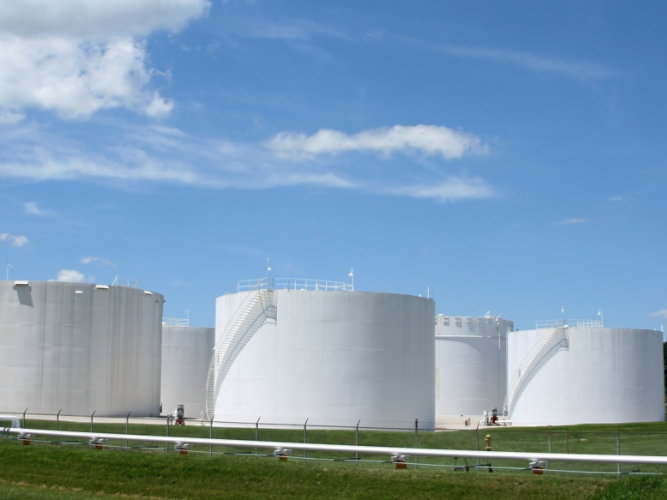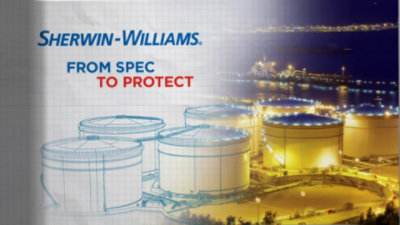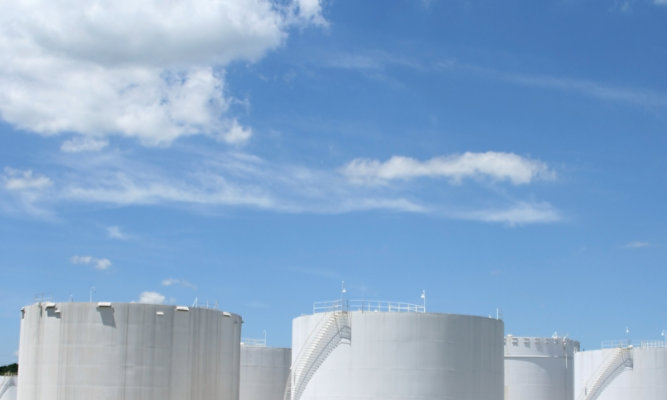Microbiological Research Drives New Coating Solutions for Combating Ethanol Tank Mold
Drawing from microbial identification methods used by Irish whiskey distillers, microbiologists from Sherwin-Williams pinpointed the species of black mildew tarnishing ethanol tank exteriors – and identified a coating formulation with superior performance for preventing its growth.
by Justin Hair, Oil & Gas Midstream Market Manager, Sherwin-Williams Protective & Marine, and Tony Rook, R&D Associate Director, Global Microbiology Resource Center, Sherwin-Williams Global Supply Chain

Black-colored mildew tends to grow aggressively on the exterior of aboveground ethanol storage tanks, requiring frequent costly washings and potentially damaging protective coatings. In addition, the dark fungus can accelerate the evaporation of fuel stored inside tanks by attracting more heat.
An oil and gas facility’s reputation can also be affected. The sight of black mildew on a tank’s exterior can lead to questions about the integrity of a facility, its practices and level of compliance with regulations – especially in high-consequence areas (HCAs) that can be subject to elevated scrutiny.
To address the issue, scientists from Sherwin-Williams used an inventive, first-in-the-industry strategy for identifying persistent black mildew so they could determine how to best combat it. This discovery enabled improvements to current test methods, which led to the identification of coating formulations with superior capacity to prevent mildew growth on the surface of the exterior of aboveground storage tanks. To further prove the performance of the coatings, Sherwin-Williams conducted field tests by painting sample patches onto an ethanol storage tank that was exhibiting mildew defacement.
The research yielded promising results, showing that a particular coating formulation controlled the growth of black-colored mildew on ethanol storage tanks. The data suggests that this formulation can keep storage tank exteriors pristine for longer, potentially reducing overall operational costs with longer intervals between cleanings and new coating applications, as well as by reducing emissions from ethanol evaporation.
This is good news for refineries, terminals and other oil and gas facilities throughout North America, as ethanol storage tanks are particularly prone to mildew growth. If it is left untreated, a costly cycle can set in. The mold’s black color makes the tanks absorb more heat, which raises the temperature of the ethanol inside and leads to more of the fuel escaping from vents. These vapors further drive microbial growth on the outside of the tank, deepening its dark exterior color.
Ethanol, a liquid alcohol used as fuel or as an additive for others, has a lower boiling point than water and is prone to evaporation in warm environments – making the moderation of a storage tank’s interior temperature of utmost importance to preserve product. A whiter tank exterior promotes lower ethanol temperatures, reducing loss. Fewer fumes leaving the tank also means the black-colored mildew has less food for growth.
The Sherwin-Williams research, conducted by its industry-leading Global Microbiology Resource Center, represents a significant advancement in the understanding of how to improve sustainability at ethanol storage facilities. By identifying the specific fungal species responsible for the black mildew growth – and a coating formulation able to stifle that growth – Sherwin-Williams has found a new way for ethanol producers and storage facilities to reduce costs and enhance sustainability.
The research and findings have promise to bring a new level of consistency to the performance of ethanol tank coatings, which could minimize the need for costly cleanings and re-coatings, create maintenance efficiencies, help facilities extend asset lives and assist them with keeping more product in their tanks. Tanks could also look whiter for longer, which could invite less scrutiny onto facilities striving for positive perception in the industry and among the public.
New Fuel on the Block
The production and storage of ethanol has grown globally over the last couple of decades, along with an emphasis on the use of biofuels and other renewables. Given the relative youth of the ethanol industry, coatings used on ethanol storage tanks were generally developed for tanks storing other fuels and substances.
While exterior aboveground ethanol storage tank coatings – usually epoxy-, polyurethane- or polysiloxane-based, and formulated with a mildew-resistant (MR) additive – must meet industry and site specifications, dark-colored mildew growth inevitably starts within months on coated tanks.
Standard MR coating additives are often effective in laboratory evaluations and in some field tests, but many of these products have performed inconsistently in the environments present at oil and gas facilities.
Mildew growth has no effect on the quality of the ethanol and poses no health risk to facility workers or the public. However, its constant presence is unwelcome and can become costly for facilities and an industry striving to improve financial and environmental sustainability, while maintaining regulatory compliance.
The behavior of black mildew on ethanol tanks has become better understood and more predictable over time. Among the dust, dirt, moisture and contaminants that naturally collect on a tank shell are microorganisms – until recently, unidentified – that grow aggressively in the presence of ethanol vapors but are largely left unchecked by traditional MR coatings.
Ethanol storage facilities usually reactively clean tanks once this microbial growth is already well established. Rarely are tanks cleaned proactively to prevent mold growth altogether, given the cost of time and resources.
Pressure washing tank roofs, shells and vents requires significant amounts of water, fuel and cleaner – and often involves hiring contractors. Depending on the size of the tank, lifts, scaffolding or other specialized equipment may be necessary, in addition to other safety measures that could, even under the best execution, prove cumbersome to a facility striving to maintain normal operations. Even with facilities following regular maintenance and servicing schedules necessitated by the average growth rate of mildew, ongoing cleaning is often necessary and may need to be repeated once or twice a year, with much longer intervals also possible.
The mildew’s very presence and unsightliness can suggest issues to key constituencies where none exist. For instance, some storage facilities are near residential areas where homeowners have sometimes become concerned by the sight of blackening tanks and have contacted authorities to report what they perceive to be an environmental or health issue.
Eventually, significant damage can occur. Over time, mildew can degrade coatings – finding its way into microscopic pores to cause pitting, micro-fracturing and failure points – which eventually invites the intrusion of water and accelerates the overall coating failure. If left unchecked, mildew can cut years off the life of the coating and risk damage to the tank.
Depending on the extent of damage to a tank’s exterior coating, a new application of a common coating, such as a high-solids, high-build, fast-cure epoxy mastic like Macropoxy® 646 MR, could be necessary. Without choosing a coating with an MR additive, mildew growth would establish much quicker.
Because ethanol expands when heated, storage tanks feature roof vents that allow any excessive vapor pressure to escape. Otherwise, the tanks could develop leaks or burst open under undue pressure. The vented emissions – deemed fugitive emissions due to their unwelcome nature – create a more concentrated microenvironment of ethanol vapors around a tank with organisms using those fuel vapors as a carbon source for growth. The more a tank heats up due to solar radiant heat gain, the greater the release of ethanol vapors and the greater the potential for mildew growth.
While black mildew growth is usually strongest on tank roofs, rain and wind can also cause the microorganisms to spill over the tank shell wall, creating another source of unsightly discoloration.
Given the sheer size and value of tanks, oil and gas suppliers want to preserve the natural lives of such structures and ensure they’re protecting their investments and the products they contain.
Yet, as ethanol production and storage has grown in the last two decades, so has the mildew problem and its potential long-term consequences. In searching for solutions, the Sherwin-Williams Global Microbiology Resource Center found inspiration from an unlikely source.
Inspiration from Spirits
For centuries, whiskey distillers in Ireland faced a comparable issue, with dark-colored microbes thriving in the environment around their facilities and surrounding areas (including on nearby residences).
They eventually deduced that the black mildew was feeding on the alcohol vapors escaping whiskey casks – traditionally called “the angel’s share.” This stood somewhat against reason, as alcohol is used as a disinfectant and kills many forms of microbial growth. However, in a low-concentration vapor form, the alcohol can actually act as a food source.
A keen microbiology researcher was able to isolate the black mildew in a lab test by providing a small amount of whiskey as the sole nutrient source in media. The culprit was a particular black yeast, Baudoinia compniacensis, known colloquially as Whiskey Fungus or Distillery Fungus.
This example pointed the way for the Sherwin-Williams Global Microbiology Resource Center to tackle the issue of mildew on ethanol tanks. Using a similar strategy, microbiology scientists set out to classify the microorganism responsible for the black discoloration on ethanol tanks – and then identifying a coating capable of controlling its growth.
Following this visionary approach, it was only fitting for the first company in the paint and coatings industry to hire a chemist – Piercy Nieman, in the late 1800s – to attempt to isolate the offending microorganism. In the same vein, Sherwin-Williams was also the first North American coatings company with in-house microbiology expertise. Today, the Global Microbiology Resource Center leads research and development initiatives and provides microbial control solutions for Sherwin-Williams products and processes.
Mimicking the scheme of whiskey distillers, the Global Microbiology Resource Center team designed experiments to identify the microorganism growing on ethanol tanks. They added a 1% ethanol solution to test media as the major carbon source, as this approach would select out other molds and fungi sampled from tank roofs and shells and reveal the culprit that was causing the black discoloration.
Investigating Suspects and Narrowing the Field
At a midstream oil and gas facility in North America, Sherwin-Williams researchers collected samples of microorganisms from the surface of aboveground ethanol storage tanks. They employed specialized processes for swabbing and isolating samples in the field and transporting the environmentally isolated microorganisms in a static state back to the lab.
With a wide array of microorganisms living on the tank surface, researchers embarked on a multistep process to isolate and identify the specific mildew that was sullying tank exteriors.
First, they placed tank shell samples in a malt extract agar media containing 1% ethanol. In traditional media without ethanol, researchers knew other organisms in the samples would have outcompeted the black mildew for available nutrients. Including ethanol in the media allowed the black-colored mildew to feed on the fuel, which mimicked the natural ethanol exposure tanks experience in the field.
Observing that ethanol induced certain fungal hyphal morphological changes allowed scientists to narrow the field of potential microorganisms. Researchers used a specific type of Mass Spectrometry evaluation called Matrix Assisted Laser Desorption Ionization-Time of Flight (MALDI-TOF) to identify the organisms that responded positively to ethanol in the media. Using lasers to ionize microbial cells in a vacuum tube, the MALDI-TOF test allowed scientists to compare protein fingerprints of organisms and classify them. Researchers confirmed their MALDI-TOF findings using traditional polymerase chain reaction-based (PCR-based) sequencing.
The results identified novel unclassified Dothideales spp as the organism responsible for the dark pigmentation on tank coatings.
Armed with this new knowledge, Sherwin-Williams pivoted to test the effectiveness of antimicrobial additives against Dothideales spp. Researchers used a modified ASTM D5590 test, which uses an accelerated agar plate assay to provide data on the resistance of coatings to fungal defacement.
Results showed that the growth of Dothideales spp was controlled by specific coating formulations which were tailored to inhibit the growth of this species of mildew.
The Proof is in the Coating
Armed with these lab findings, Sherwin-Williams launched an exterior exposure field trial at the same North American facility where microbial samples were initially collected. Researchers aimed to study how common high-performance coatings – formulated with the antimicrobial additive that performed well in the lab against Dothideales spp – would fare in limiting the fungi in the real world.
The field test used three common coatings – a fast-cure epoxy mastic, an epoxy polyamide topcoat and an aliphatic, acrylic polyurethane – traditionally specified for ethanol storage tanks (Figure 1). Applicators prepared six large areas on the roof of an aboveground ethanol storage tank and applied the three coatings in two different formulations each – one with the active MR additive and the other without the additive, as a control (Figure 2).
Within weeks, five of the six test panels started to take on varying amounts of dark-colored mildew. However, the panel coated with the fast-cure epoxy mastic containing the MR additive – strongly controlled the growth of unclassified Dothideales spp. Photos taken both six months (Figure 3) and a year (Figure 4) later confirmed this clear early-performance advantage. Aerial pictures taken five years later showed the area coated with this fast-cure epoxy mastic still only had trace amounts of black mildew and was nearly all white compared to surrounding areas.
The field trial demonstrated the effectiveness of a common coating formulated with an active MR additive that can mitigate black mildew on aboveground ethanol storage tanks. The results suggest the formulation’s success stemmed from its ability to retain the additive and make that additive available over time. Even as the coating aged and weathered, researchers believe that any penetrating fungi encountered the antimicrobial additive, proving that it strongly persisted in the formulation.
What’s Next
Field trial results indicate that ethanol tanks coated with the fast-cure epoxy mastic featuring the Sherwin-Williams antimicrobial resistance technology could benefit in a number of ways.
With less aggressive mildew growth, oil and gas facilities would be able to lengthen cleaning intervals and likely use lighter chemical treatments combined with lower-pressure washings – leading to maintenance savings and efficiencies.
Ethanol tanks without black mildew would remain whiter for longer, which would lead to lower interior temperatures and less evaporation of fuel – promoting environmental and financial sustainability by reducing emissions. Those reduced emissions would also reduce the available nutrients for the black mildew to proliferate. Plus, cleaner-looking facilities are likely to be less susceptible to scrutiny influenced by tank discoloration.
While the antimicrobial coating formulation is not yet commercially available, Sherwin-Williams is conducting additional tests to study its characteristics and potential to aid other industries and facilities in combating mold and mildew. This includes tests with other common coating formulations, including polyurethanes and polysiloxanes, to determine their capabilities. These latest studies will be informed by the ongoing scientific discoveries – and solutions – of the Sherwin-Williams Global Microbiology Resource Center.
ABOUT THE AUTHORS
Justin Hair is Oil & Gas Midstream Market Manager for Sherwin-Williams Protective & Marine based in Tulsa, Oklahoma. With approximately 30 years of service dedicated to the oil and gas coatings industry – both as an industrial painting contractor and a Sherwin-Williams oil and gas team member – he has specialized in multiple subject matters related to aboveground petroleum storage tank industry challenges. Contact: Justin.M.Hair@sherwin.com.
Tony Rook is R&D Associate Director of the Global Microbiology Resource Center for The Sherwin-Williams Company. With more than 25 years of industry experience, including 14-plus years at Sherwin-Williams, he has specialized in industrial microbiology research in the consumer product industries with the most recent focus on paints and coatings, among other areas. Rook leads the center in providing microbial control solutions to the company’s products and processes. Contact: Tony.A.Rook@sherwin.com.
Figure 1. Sherwin-Williams conducted a field trial to compare different coating formulations, with and without an antimicrobial additive, applied to the top of a large aboveground ethanol storage tank. The coatings included a fast-cure epoxy mastic, an epoxy polyamide topcoat and an aliphatic, acrylic polyurethane.
Figure 2. Applicators prepared six large areas on the tank’s roof and applied the three coatings in two different formulations each – one with an active mildew-resistant (MR) additive to mitigate Dothideales spp growth and the other without the additive.
Figure 3. At six months following the coating applications, five of the six test panels experienced varying amounts of dark-colored mildew growth. The panel coated with the fast-cure epoxy mastic containing the MR additive (e.g., the whitest panel shown on the middle left of the roof) strongly controlled the growth of unclassified Dothideales spp.
Figure 4. After one year of exposure, the area coated with the fast-cure epoxy mastic still only showed trace amounts of black mildew in stark contrast to the other test panels and surrounding areas.
Discover More
Industry Expertise and Innovation
See how we help customers find customized solutions for their project and application challenges.
Our Oil & Gas Expertise
Explore our industry solutions and technology to help protect your assets.
LEARN MOREProduct Lookup
Find out more about our innovative coatings for a variety of industries.
FIND A PRODUCT

